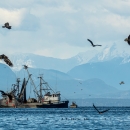
The U.S. Fish and Wildlife Service (Service) is releasing the final Environmental Assessment (EA), Finding of No Significant Impact (FONSI), and findings document for the issuance of an Incidental Eagle Take Permit (IETP) for the operation of the Campbell Hill Wind Energy Project located in Converse County, Wyoming. The 8-year permit authorizes the potential take of bald and golden eagles associated with the operation of the existing 66-turbine wind energy Project, and outlines required conservation and compensatory mitigation measures for minimizing and offsetting potential eagle take, pursuant to the 2016 regulations of the Bald and Golden Eagle Protection Act (Eagle Act). Three Buttes Windpower, LLC, a wholly owned subsidiary of Duke Energy Sustainable Solutions (Applicant), is the developer and operator of the existing and operating Project.
Project Description
The Applicant is the developer and operator of the existing Project located in Carbon and Albany Counties, Wyoming. The Project consists of 66 wind turbines and associated infrastructure (roads, transmission lines, etc.) and has been operating since December 2009. The expected life of the project is at least 8 years. The Applicant submitted the original IETP application and ECP to the Service on November 23, 2015, which was ultimately revised, to request an 8-year permit.
Potential Eagle Impacts
Monitoring conducted at the Project since 2009 has documented golden eagle mortalities. Take, including killing of eagles, is prohibited by the Eagle Act. However, the Service has been delegated the authority to issue eagle take permits, where the take is determined to be compatible with the preservation of eagles. The Service will issue permits for such take only after an applicant has committed to undertake all practical measures to avoid and minimize such take and mitigate anticipated take to the maximum extent achievable.
The Applicant has developed and provided an ECP that summarizes project design, construction and operational measures taken to avoid and minimize impacts to eagles, and results of pre- and post-construction monitoring efforts.
The Service has completed an EA for the potential issuance of the permit decision under the 2016 Eagle Act regulations. The EA assesses the potential effects of issuing an IETP and a No Action alternative (i.e., do not issue a permit) on the human and natural environment. The Service’s Collision Risk Model (CRM) predicts that up to 3.78 bald eagles and up to 7.74 golden eagles could be killed incidentally on an annual basis as a result of the operation of the Project. This was partially derived using the Evidence of Absence statistical approach to inform the CRM by analyzing post-construction mortality monitoring data collected at the Project site from 2016 –2019. Additionally, national priors were used to update the CRM eagle exposure parameter. Lastly, collision probability prior was updated iteratively using the expected value of fatalities and adjusted for applicant-provided operational daylight hour data collected during monitored years (2016-2020).
Project Review
The Service has an independent statutory responsibility under the National Environmental Policy Act (NEPA) to evaluate its own actions related to the Project, namely the possible issuance of an IETP. A draft EA evaluating the impact of issuing (and not issuing) an IETP for the existing Project was made available for a 30-day comment period. We received one letter containing comments and recommendations during the public review period. It has been determined that there is no new significant information, and the Service has prepared a FONSI in accordance with NEPA regulations (40 C.F.R § 1508.13). The IETP will be issued under the 2016 Eagle Act regulations and will authorize non-purposeful take of bald eagle and golden eagles.
Draft Environmental Assessment
This draft Environmental Assessment (EA) was prepared to analyze the environmental consequences of the U.S. Fish and Wildlife Service (Service) issuing an incidental eagle take permit (IETP) for the take of bald (Haliaeetus leucocephalus) and golden (Aquila chrysaetos) eagles associated with the existing and operating Campbell Hill Wind Power project (collectively “Project”), pursuant to the National Environmental Policy Act (NEPA) (42 United States Code [U.S.C.] §§ 4321–4347). NEPA’s supporting regulations are at 40 C.F.R. Part 1500; see also 46 C.F.R. Part 46. It is a discretionary Federal action for the Service to issue an IETP under the Bald and Golden Eagle Protection Act (Eagle Act), (16 U.S.C. §§ 668–668d; see also 50 C.F.R. § 22.26). This Federal action is therefore subject to NEPA. This draft EA assists the Service in ensuring compliance with NEPA, and in making a determination as to whether any “significant” impacts could result from the analyzed actions that would require preparation of an Environmental Impact Statement (EIS). This draft EA evaluates the effects of alternatives for our decision whether to issue an IETP.
Eagle Conservation Plan (ECP)
On July 23, 2019, the US Fish and Wildlife Service (USFWS) Region 6 Migratory Bird Office released a new guidance document for development of Eagle Conservation Plans (ECP) titled U.S. Fish and Wildlife Service, Region 6, Recommended Approach for Development and Submission of Eagle Conservation Plans to be submitted in support of an Eagle Incidental Take Permit [EITP] Application for Wind Energy Project. The following document has been prepared to address the items identified by ECP Regional Guidance and is intended to serve as an ECP in support of an IETP application for the Campbell Hill Wind Power project (collectively “Project”). Per the Guidance, the text in this ECP is limited primarily to summaries with reference to technical reports provided as appendices (available upon request). This document does not elaborate on every study, but rather emphasizes data that support the document objective: eagle conservation.
Additional documents and Appendices are available upon request.





